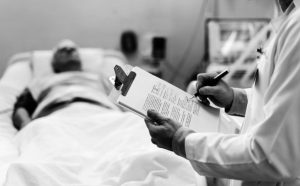During the COVID-19 pandemic, the world has turned its eye towards medical laboratory professionals. For those of us in this profession, a profession that has often been behind those biohazard labeled doors, the time has finally arrived for the public and those in healthcare to truly understand our value to saving lives. Simply put, medical laboratory professionals are the doctor’s doctor.
often been behind those biohazard labeled doors, the time has finally arrived for the public and those in healthcare to truly understand our value to saving lives. Simply put, medical laboratory professionals are the doctor’s doctor.
Medical Laboratory Scientist (MLS) professionals provide up to 70 percent of patients' laboratory testing to physicians so they can provide an accurate diagnosis and treatment plan, according to one study, which also concluded that 94 percent of the objective medical data in the patient record comes from the laboratory professionals.
But while the world deals with a major pandemic, the profession is fighting major shortages of personnel. While the U.S. and world clamor and scream for “more tests” during the SARSCoV2 pandemic, many would be led to believe that our largest hurdle to help our patients is the lack of COVID-19 tests and pre-analytical (extraction reagents, etc.) supplies. But the biggest hurdle of all is the lack of medical laboratory professionals who conduct those tests.
A quick look at the number of employed medical laboratory professionals in the U.S. shows about 310,000 individuals. If you do the simple math, the United States has a population of roughly 350 million people. As Medical Laboratory Scientist Megan Ledford pointed out earlier this month, for laboratory professionals who take the brunt of all tests, that leaves about 1,129 people per one medical laboratory scientist, and one person averages 39 various tests per year, which culminates in 14 billion tests.
Now, fast forward to what is happening all over the U.S. and world. Hundreds of thousands of SARS-CoV-2 / COVID-19 tests are being run. Put that on top of the workload and one can quickly see that it would take way over the normal 40-hour work period to make testing happen. And just because there is a pandemic does not mean other diseases stop. People do not stop having heart disease, diabetes, influenza infections, pregnancies, just because of a pandemic due to a single virus. On top of that, medical laboratory professionals risk catching the disease just like other health professionals, and when they do, that only compounds the manpower shortage.
These tests are not just loaded on machines that do the work, either. Medical laboratory and public health professionals spend countless hours conducting correlation and validation tests to ensure that the equipment and standards are performing these tests accurately. In many aspects, medical laboratory professionals are expert computer scientists mastering complex hardware and software for laboratory information systems to “talk” to the patient electronic health record, equipment technicians, statisticians, and trouble-shooters across a diverse landscape of medical expertise.
It is likely that shortages may get worse. Nationally, there are approximately 2,600 MLS and 2,300 MLT students graduating each year, creating a total of 4,900 new personnel to fill over 9,100 job openings – resulting in a 46% vacancy rate. This is a statistic that can be cured with more awareness - if students who loved science knew the amazing laboratory medicine profession has an actual college major, many might leverage that love of science into this career path.
This pandemic highlights the growing crisis of shortages of both medical laboratory and public health professionals. The ongoing nature of epidemic threats doesn’t care – but you should. My colleagues and I hope that you will begin to share more about who we are and what we do. You may not see us, or know who we are, but you need us in those labs, doing the essential work of diagnosing disease.
Published in Forbes, April 20, 2020
Read more about the MLS profession- Revealing the Hidden Profession That Saves Lives



Share Article